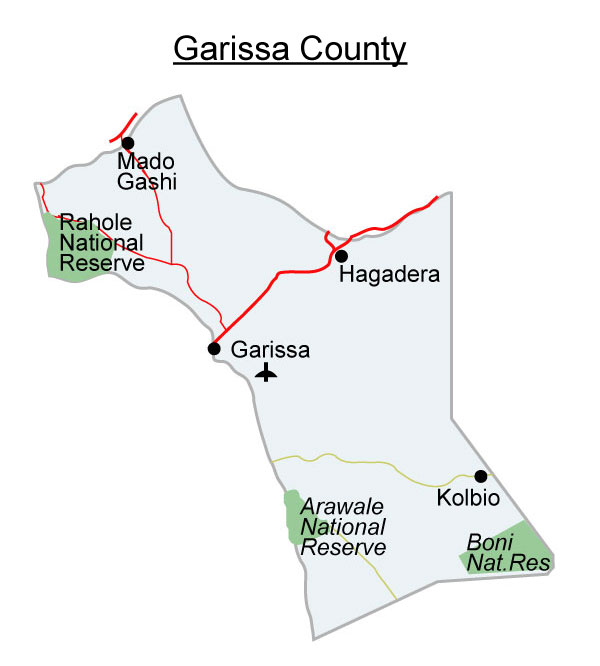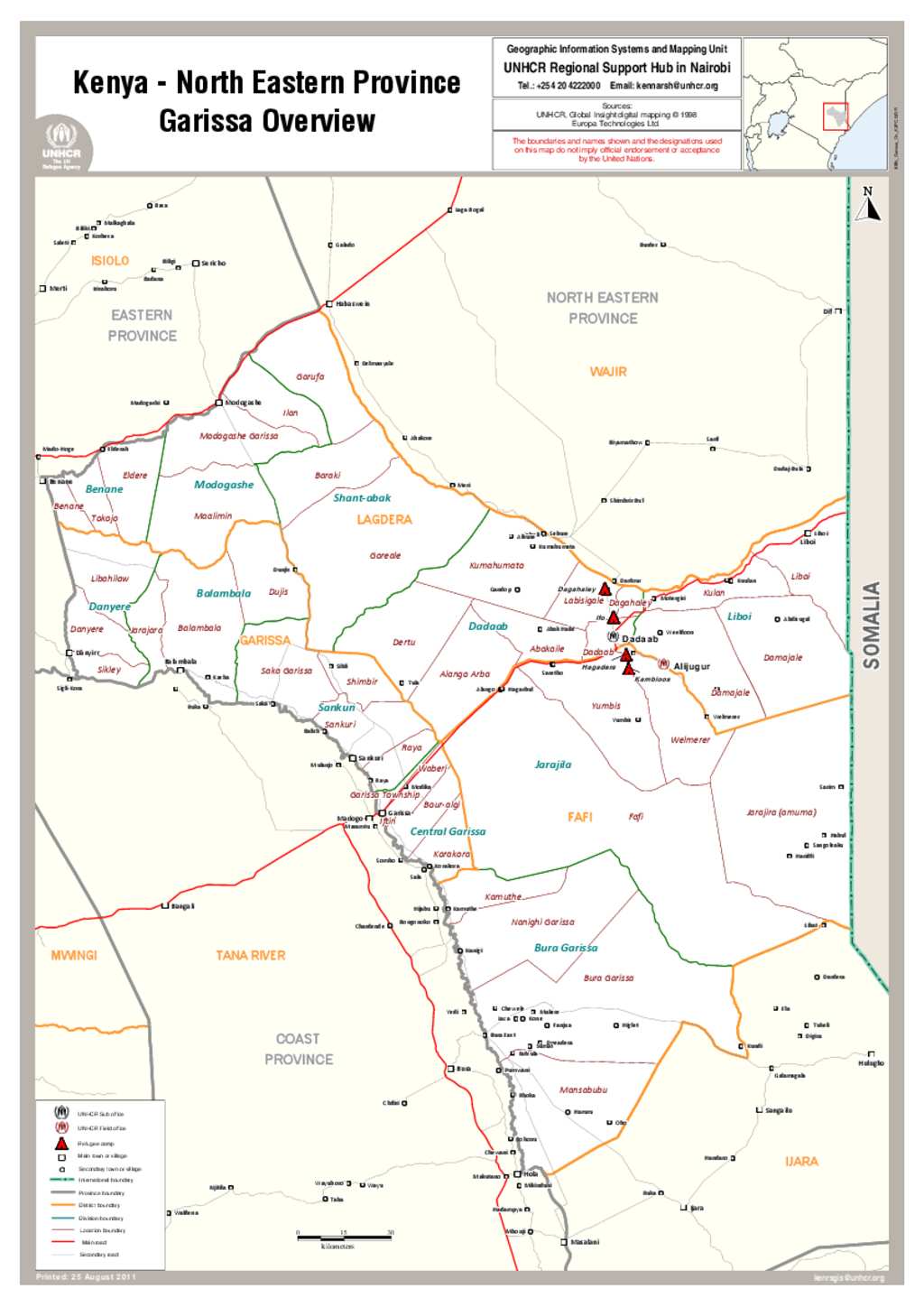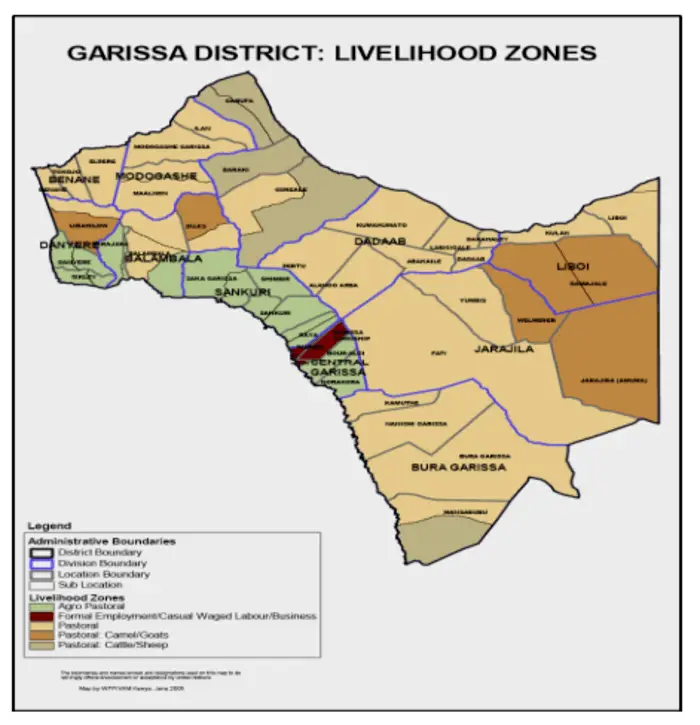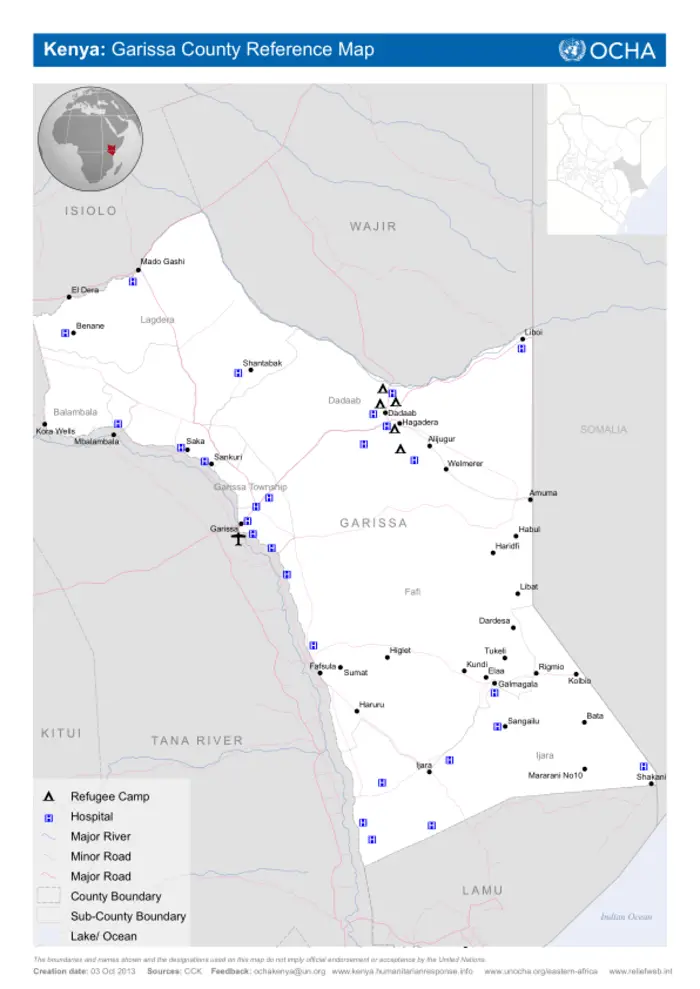Garissa County, located in the eastern part of Kenya, is a captivating destination that offers a unique blend of cultural diversity and natural beauty. With a rich history and heritage, this friendly county is home to various ethnic communities, each contributing to the vibrant tapestry of its society. The expansive wilderness of Garissa County also boasts an array of breath-taking landscapes, from the rolling plains of Ijara to the majestic Tana River. Whether you’re exploring the vibrant local markets, immersing yourself in the cultural festivities, or embarking on thrilling wildlife safaris, Garissa County guarantees an unforgettable adventure filled with warm hospitality and endless discoveries.

This image is property of opencounty.org.
Location
Geographical location
Garissa County is located in the northeastern part of Kenya, bordering Somalia to the east. It is in the arid and semi-arid region of the country, characterized by hot and dry weather throughout the year. The county covers an area of approximately 45,720 square kilometers, making it one of the largest counties in Kenya.
Bordering counties
Garissa County shares its borders with four other counties: Wajir to the north, Isiolo to the west, Tana River to the south, and Lamu to the southeast. These neighboring counties contribute to the cultural diversity and economic activities of Garissa County.
History
Early settlement
Garissa County has a rich history, with evidence of human settlement dating back thousands of years. The area was initially inhabited by various pastoralist communities, including the Somali, Borana, and Orma. These communities relied on livestock rearing as their primary source of livelihood.
Colonial era
During the colonial era, Garissa County was under British rule. The British established a military base in the area to control trade routes and maintain order. This had a significant impact on the region’s development and contributed to the establishment of infrastructure such as roads and schools.
Independence and post-independence
Like the rest of Kenya, Garissa County gained independence in 1963. The county has since experienced significant growth and development, with the government implementing various programs and initiatives to improve the quality of life for its residents. However, challenges such as poverty, unemployment, and insecurity continue to persist.
Demographics
Population
Garissa County has a diverse population, with various ethnic groups living in the area. According to the latest census data, the county has a population of approximately 841,000 people. The population is mainly concentrated in urban centers such as Garissa, Hulugho, and Balambala.
Ethnic composition
The county is home to several ethnic groups, including the Somali, Borana, Orma, and Swahili. The Somali community is the largest, making up the majority of the population. These different ethnic groups contribute to the cultural diversity and social fabric of Garissa County.
Religion
Islam is the predominant religion in Garissa County, with the majority of the population being Muslim. Mosques can be found in various parts of the county, serving as places of worship and community gathering. Other religious groups, such as Christians, also exist within the county.
Languages spoken
The Somali language is widely spoken in Garissa County, as the Somali community forms the majority. However, other languages such as Borana, Orma, and Swahili are also spoken by different ethnic groups. Swahili is the lingua franca and is widely understood and used for communication among different communities.
Governance
County government
Garissa County is headed by a governor who is elected by the residents. The county government is responsible for the provision of essential services such as healthcare, education, and infrastructure development. It plays a crucial role in addressing the unique challenges faced by the county, such as poverty and unemployment.
County leadership
The current governor of Garissa County is Ali Bunow Korane, who assumed office in 2017. Under his leadership, the county government has prioritized development projects to improve the lives of its residents. The county assembly, consisting of elected members, works closely with the governor in making decisions for the county.

This image is property of elimufeynman.s3.amazonaws.com.
Economy
Agriculture
Agriculture forms a significant part of the economy in Garissa County. The county has vast agricultural potential, with fertile soils and suitable climatic conditions for crop farming. Drought-resistant crops such as millet, sorghum, and maize are commonly grown in the area. The county government has implemented various initiatives to promote agricultural practices and provide farmers with necessary support and resources.
Livestock
Livestock rearing is a traditional livelihood for many communities in Garissa County. The county has vast grazing lands, making it suitable for keeping cattle, goats, sheep, and camels. Livestock farming is not only a source of income but also plays a crucial role in the cultural practices and identity of the communities in the county.
Tourism
Garissa County has significant tourism potential, thanks to its unique natural attractions and cultural heritage. The county is home to various wildlife reserves, including Boni National Reserve and Ijara Wildlife Conservancy. These reserves attract tourists interested in wildlife safaris and eco-tourism.
Trade and commerce
Trade and commerce play a vital role in the economy of Garissa County. The county is strategically located along major trade routes, making it a hub for regional trade. The county government has implemented measures to improve infrastructure and create a conducive environment for business activities.
Education
Primary and secondary schools
Garissa County has made significant progress in improving access to education for its residents. The county has numerous primary and secondary schools, providing quality education to children and young adults. Efforts have been made to improve infrastructure and increase the number of trained teachers, ensuring a conducive learning environment for students.
Tertiary institutions
The county is home to several tertiary institutions, including Garissa University. These institutions offer a wide range of courses and programs, providing young adults in Garissa County access to higher education. The county government has also initiated scholarship programs and vocational training to empower the youth with employable skills.
Literacy rate
The literacy rate in Garissa County has improved over the years, although there is still room for further progress. Efforts have been made to promote literacy through adult education programs and awareness campaigns. The county government continues to invest in improving literacy rates to enhance the overall development of the county.

This image is property of data.unhcr.org.
Healthcare
Health facilities
Garissa County has several healthcare facilities that provide essential medical services to residents. These facilities range from dispensaries and health centers to larger hospitals. The county government has invested in the construction and equipping of healthcare facilities, ensuring that residents have access to quality healthcare services.
Health indicators
Despite efforts to improve healthcare services, Garissa County continues to face challenges in terms of health indicators. Maternal and child mortality rates are still relatively high compared to national averages. The county government is working closely with healthcare professionals and stakeholders to address these challenges and improve overall health outcomes.
Infrastructure
Transportation
Garissa County is connected to the rest of the country through a network of roads and highways. The county has made significant progress in improving road infrastructure, making it easier for residents and businesses to travel and transport goods. Efforts have also been made to improve public transportation services, ensuring accessibility and mobility for all.
Energy
Access to reliable energy is crucial for the development of any region, and Garissa County is no exception. The county has made progress in improving access to electricity, with the government implementing various projects to increase power generation and distribution. Renewable energy sources, such as solar power, are also being explored as a sustainable energy solution.
Water and sanitation
Garissa County faces water scarcity due to its arid and semi-arid climate. The county government has implemented water projects to improve access to clean and safe water for residents. Efforts have also been made to promote proper sanitation and hygiene practices, ensuring a healthier environment for the county’s population.

This image is property of reliefweb.int.
Culture and Tourism
Cultural practices
Garissa County is rich in cultural heritage, with diverse communities practicing traditional customs and rituals. The Somali culture, in particular, plays a significant role in shaping the county’s cultural identity. Traditional dances, music, and dress are celebrated and preserved, promoting cultural diversity and social cohesion.
Tourist attractions
Garissa County boasts various tourist attractions, attracting visitors from around the world. Boni National Reserve is a wildlife sanctuary known for its diverse flora and fauna. The Garissa Museum showcases the county’s cultural artifacts and history. The Tana River, with its scenic beauty, offers opportunities for boating and water sports.
Festivals and events
The county celebrates various festivals and events that showcase its rich cultural traditions. The East Africa Trade Fair brings together traders from different regions, promoting business and cultural exchange. Additionally, religious festivals such as Eid al-Fitr and Eid al-Adha are celebrated by the Muslim community with great enthusiasm and unity.
Challenges
Security
Garissa County faces security challenges due to its proximity to Somalia and the porous border. In the past, the county has experienced terrorist attacks and incidents of inter-communal violence. The government continues to work closely with security agencies to enhance surveillance and maintain peace and stability in the region.
Poverty
Poverty remains a significant challenge in Garissa County, with a significant portion of the population living below the poverty line. The county government has implemented poverty alleviation programs, including skills training and access to microfinance, to empower residents and improve livelihoods.
Unemployment
Garissa County faces high rates of unemployment, particularly among the youth. The county government has prioritized job creation through initiatives such as the establishment of industrial parks, promoting entrepreneurship, and providing vocational training. Efforts are also being made to attract investment and enhance the business environment.
Drought and climate change
Garissa County is prone to droughts, exacerbated by climate change and variability. These climatic conditions pose a significant challenge to agriculture and livelihoods, with frequent crop failure and loss of livestock. The county government is implementing measures such as water harvesting and promoting climate-resilient farming practices to mitigate the effects of drought and climate change.
In conclusion, Garissa County is a unique and diverse region in Kenya, with a rich cultural heritage and untapped potential for tourism and economic growth. Despite facing challenges such as poverty, unemployment, and security threats, the county government, in collaboration with stakeholders, is working towards addressing these issues and improving the overall well-being of its residents. With ongoing efforts in infrastructure development, education, healthcare, and sustainable agriculture, Garissa County is poised for a brighter and more prosperous future.

This image is property of reliefweb.int.


